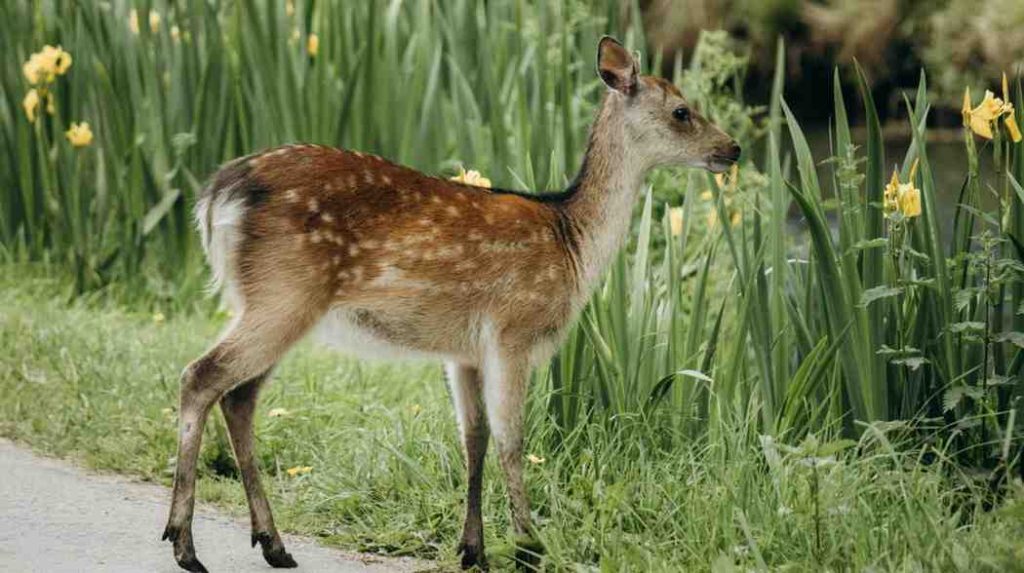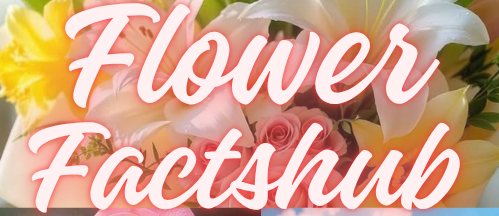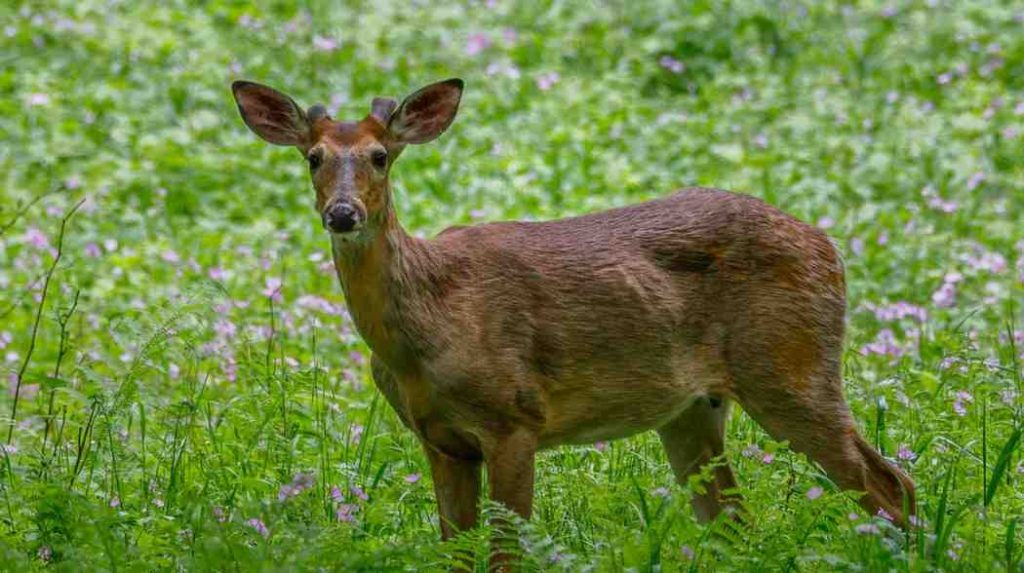If you have ever spent time and effort growing a beautiful garden only to wake up and find it eaten by deer. Deer are known for their appetite and unfortunately your favorite flowers might be on their menu. However, there’s a smart and effective way to protect your garden without fences or repellents planting deer resistant flowers.
Deer-resistant flowers are not completely immune to browsing, but they are far less appealing to deer because of their texture, taste, or scent. These plants allow gardeners to enjoy a vibrant, colorful landscape without constantly worrying about wildlife damage. Whether you are a beginner or an experienced gardener, understanding which flowers deer tend to avoid can save time, money and frustration while still giving you a beautiful garden to enjoy year-round.
Do deer-resistant flowers really work?
Yes, deer-resistant flowers truly work but with a bit of nuance. While no plant is 100% deer-proof, certain flowers are naturally unappealing to deer due to their scent, taste, or texture. Flowers like lavender, salvia, and daffodils have characteristics that make deer turn the other way. However, in times of extreme hunger or limited food, deer may sample almost anything. That’s why combining deer-resistant plants with other deterrents (like fencing or repellents) offers the best protection.
Deer-resistant flowers are an effective first line of defense, helping reduce the chances of damage while still allowing you to maintain a beautiful, blooming garden.
Challenge of Deer Damaging Gardens
For many gardeners, deer can be one of the most frustrating and persistent challenges. These graceful animals may look harmless, but when it comes to your garden they can be surprisingly destructive. Deer often wander into residential yards in search of food, especially in areas where their natural habitat overlaps with suburban landscapes. Unfortunately, many of the flowers and plants we love most like tulips, roses, and hostas are exactly what deer find delicious. What makes the problem worse is that deer are not easily deterred. They can leap over fences, ignore certain repellents and even return night after night once they discover a food source. A single visit can leave flower beds stripped, buds eaten and entire plants damaged beyond recovery. This ongoing threat can be discouraging, especially for gardeners who invest time, money, and passion into their outdoor spaces. That’s exactly why choosing deer resistant flowers is not just a smart option it’s a long-term strategy to protect your garden while maintaining its natural beauty.
Some Flowers Are Less Attractive to Deer
It’s important to understand that no plant can be guaranteed 100% deer-proof. Deer are opportunistic feeders, and if food is scarce especially during dry seasons or winter they may bite on almost anything, even plants they usually avoid. However, that doesn’t mean you’re out of options.
Many flowers are naturally less appealing to deer due to their scent, texture, or taste. Deer tend to avoid plants that have strong fragrances, fuzzy or leathery leaves, or bitter and toxic compounds. By choosing these types of flowers, you significantly reduce the chances of your garden being raided. While it’s not a perfect shield, selecting the right varieties can give you peace of mind and a much better chance of keeping your flower beds full and flourishing throughout the growing season.
Why Do Deer Avoid Certain Flowers
Deer, like many animals, rely on their senses to decide what to eat and what to avoid. Certain flowers naturally repel them because of how they smell, feel or taste. For example, plants with strong or pungent scents such as lavender, sage, or marigolds can overwhelm a deer’s sensitive nose, making those blooms unappetizing. Likewise, flowers with fuzzy, thorny, or leathery textures can be physically unpleasant for deer to chew.
In addition to texture and scent, chemical composition also plays a major role. Some flowers contain bitter compounds or toxins that not only taste bad to deer but can also upset their stomachs. Over time, deer learn to steer clear of those plants. This natural instinct is what makes certain flowers more “deer-resistant.” Understanding these patterns helps gardeners choose plants that deer are far less likely to bother, even in seasons when food is limited.
Top Deer Resistant Flowers for Your Garden
Now that we understand why deer avoid certain flowers, let’s explore some of the top choices you can confidently plant in your garden. These flowers not only add vibrant color and beauty to your landscape but also help reduce the risk of deer damage naturally.
- Lavender: Known for its soothing fragrance to humans, lavender’s strong scent is a natural deer deterrent. It also thrives in sunny, dry areas, making it a great low-maintenance option.
- Marigolds: These bright, cheerful blooms release a pungent aroma that deer find unpleasant. They’re excellent for borders and can double as pest control against insects.
- Salvia: This hardy perennial has textured leaves and a strong smell that keeps deer away. It also attracts pollinators like bees and butterflies.
- Peonies: While their lush blooms are beloved by gardeners, deer tend to avoid peonies due to their bitter taste and thick foliage.
- Daffodils: Toxic to deer, daffodils are a classic springtime flower that also sends a clear “stay away” message to wildlife.
- Coneflowers (Echinacea): These tough native perennials hold their own in many climates and are rarely touched by deer, thanks to their coarse leaves and central spiky cone.
- Bee Balm (Monarda): With its strong minty scent and vibrant blooms, bee balm is another top pick for both beauty and resistance.

Each of these flowers offers unique color, height, and texture to your garden design while also helping you maintain a peaceful coexistence with local wildlife. By incorporating a mix of these, you can enjoy a thriving garden that’s naturally more protected.
Flowers Deer Love
While some flowers act as natural deterrents, others seem to be irresistible treats for deer. Knowing which plants to avoid can be just as helpful as knowing which ones to choose. Unfortunately, many popular garden flowers fall into the “deer favorite” category, often because they are soft, tender and lightly scented just the way deer like them.
- Tulips: These springtime favorites are like candy to deer. Their soft petals and mild flavor make them an easy target, especially when food sources are limited.
- Roses: Despite their thorns, deer often nibble on rosebuds and new shoots. Hybrid tea roses and other varieties with soft leaves are particularly vulnerable.
- Hostas: With their broad, leafy foliage, hostas are a go-to snack for deer. Their lush texture and mild taste make them highly attractive.
- Daylilies: These vibrant, fast-growing perennials are another common target. Deer often eat the buds before they even bloom.
- Impatiens: Loved for their bright colors and shade tolerance, impatiens unfortunately top the menu for deer in many gardens.
- Pansies and Violas: These cold-hardy flowers are often among the first to bloom and the first to get eaten if deer are nearby.
If you can’t part with these beautiful plants, consider placing them in protected areas or using them alongside more deer-resistant varieties. Knowing which flowers deer tend to love helps you plan more strategically, saving both your garden and your peace of mind.
Tips for Designing a Deer Resistant Garden
Designing a garden that naturally resists deer takes a bit of strategy, but it’s well worth the effort. Instead of simply planting random deer-resistant flowers, thoughtfully arranging your garden can create a beautiful, harmonious space that discourages deer from visiting altogether.
First, use layering techniques plant taller deer-resistant shrubs or trees around the perimeter of your garden. This natural barrier can make your flower beds less accessible and less inviting to deer. Next, mix deer-resistant flowers with a few less-resistant favorites, so if deer do come around, they’re less likely to cause major damage. Placing highly deer-resistant plants like lavender or sage near vulnerable plants acts as a natural shield.
Another key tip is to vary textures and scents. Deer dislike gardens that overwhelm their senses with strong smells and rough textures. Combine aromatic herbs, fuzzy foliage, and spiky leaves for a garden that’s both interesting and off-putting to deer. Also, consider planting flowers that bloom in different seasons, ensuring that your garden always has something attractive to look at even when certain plants are out of season.
Finally, don’t forget to maintain your garden regularly. Prune overgrown plants and remove fallen fruit or leaves, as these can attract deer. By planning and caring for your garden with deer resistance in mind, you create a space that stays beautiful, healthy and more peaceful year round.
Natural Deterrents to Use Alongside Deer Resistant Flowers
While planting deer-resistant flowers is a solid first step, combining them with natural deterrents can further protect your garden from hungry visitors. Using these eco-friendly methods helps create a multi-layered defense without harming the animals or the environment.
One effective approach is to incorporate aromatic herbs like mint, rosemary, thyme, and garlic around your garden beds. These plants emit strong scents that deer find unpleasant, acting as natural “invisible fences.” Additionally, planting herbs alongside flowers not only deters deer but also attracts beneficial pollinators, adding another layer of garden health.
Another popular natural deterrent is homemade sprays made from ingredients like garlic, hot pepper, or soap. Spraying these on vulnerable plants can discourage deer by making the foliage taste bitter or irritating. Just remember to reapply after rain or watering for best results.
You can also use physical barriers like mesh fencing or netting in key spots, especially during peak deer activity seasons. Combining barriers with natural deterrents and deer-resistant flowers creates a comprehensive strategy that reduces the chances of damage significantly.
By integrating these natural deterrents with your choice of plants, you build a garden that’s not only beautiful and diverse but also smartly protected against deer without relying on harsh chemicals or constant vigilance.
Common Mistakes Gardeners Make with Deer Control
Even the most passionate gardeners can fall into some common traps when trying to keep deer out of their gardens. Understanding these mistakes can save you time, money, and frustration while improving your garden’s resilience.
One major mistake is relying solely on repellents or sprays. While these can help temporarily, deer often become accustomed to scents and tastes over time, making repellents less effective. Using them without combining other strategies usually leads to disappointing results.
Another error is planting vulnerable, deer-favorite flowers without any protection in areas heavily trafficked by deer. Even if you love tulips or hostas, placing them in an open space without barriers invites deer damage. Gardeners sometimes forget that location matters as much as plant choice.
A third common oversight is not maintaining garden defenses regularly. For example, fences left unrepaired or repellents not reapplied after rain lose their effectiveness quickly. Neglecting garden upkeep can undo all your hard work in deterring deer.
Lastly, some gardeners expect a one-size-fits-all solution. Deer behavior varies by region and season, so strategies that work well in one garden might fail in another. Observing your local deer patterns and adjusting your approach accordingly is essential.
By avoiding these mistakes and combining thoughtful plant choices with consistent care and multiple deterrent methods, you’ll greatly improve your chances of keeping your garden deer-resistant and thriving.
Creating a Garden Deer Can Admire From a Distance
Creating a deer-resistant garden is both an art and a science. While no garden can be completely deer-proof, choosing the right flowers, designing thoughtfully, and using natural deterrents can help you enjoy a beautiful outdoor space without constant worry about deer damage. The key is understanding deer behavior and working with nature rather than against it.
By embracing plants that deer tend to avoid and layering your defenses smartly, you not only protect your garden but also encourage biodiversity and sustainability. Remember, the goal isn’t to create a fortress, but rather a harmonious environment where your garden thrives, and deer simply move along without causing harm.
With patience and consistent care, your garden will become a place of vibrant colors, interesting textures, and natural beauty a space that delights both you and your local wildlife, from a respectful distance.
Final Thoughts
Creating a deer-resistant garden doesn’t mean sacrificing beauty. In fact, many of the most vibrant and fragrant flowers are naturally avoided by deer. With smart planning and thoughtful planting, you can design a garden that’s both stunning and secure. The flowers listed above not only add charm to your yard but also help maintain your hard work by keeping deer at a respectful distance.
By choosing the right plants, you turn your garden into a place of harmony where nature thrives without becoming a battleground. Deer-resistant flowers give you the best of both worlds: lush, colorful blooms and fewer intruders nibbling on your plants. It’s a win-win for gardeners and gardens alike.
Frequently Asked Questions (FAQs)
Q1: What makes a flower deer-resistant?
Flowers with strong scents, bitter tastes, or fuzzy textures are less appealing to deer and often left alone.
Q2: Will deer ever eat deer-resistant flowers?
Sometimes, yes — especially during droughts or winter. No plant is completely deer-proof.
Q3: Are there deer-resistant flowers that attract pollinators?
Absolutely! Bee balm, lavender, and salvia attract bees and butterflies while repelling deer.
Q4: Can I use these flowers in container gardens too?
Yes! Many deer-resistant flowers thrive in pots, raised beds, and containers, especially on porches and patios.
Q5: Should I still use deer repellents with these flowers?
For added protection, especially in high-deer areas, it’s wise to combine plants with natural repellents or physical barriers.



